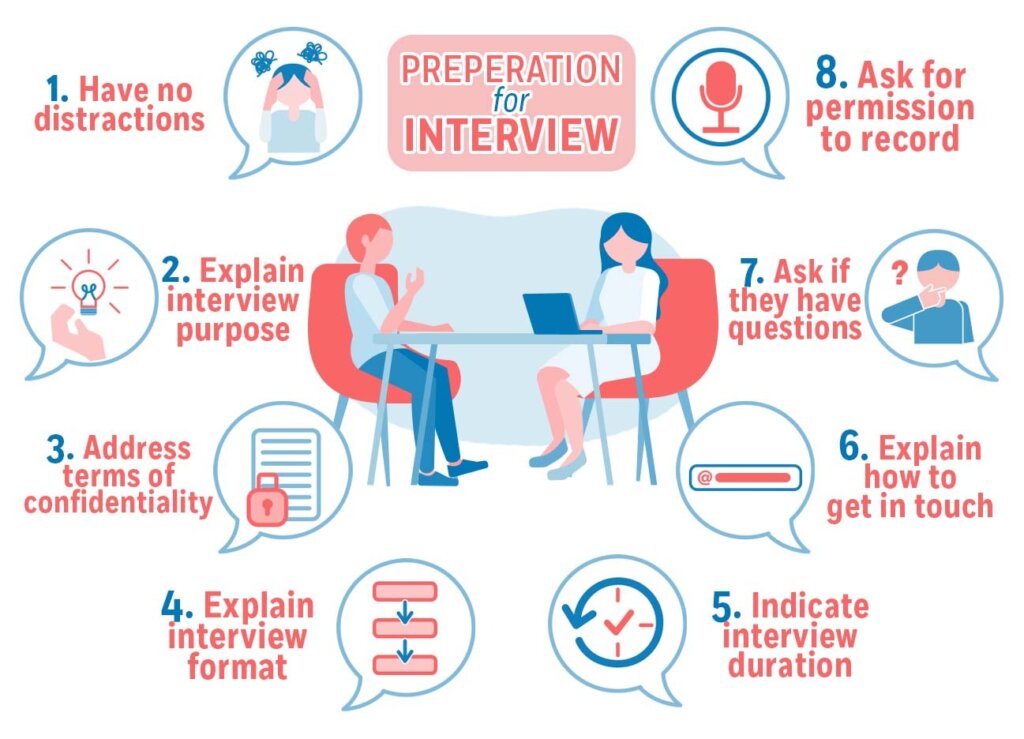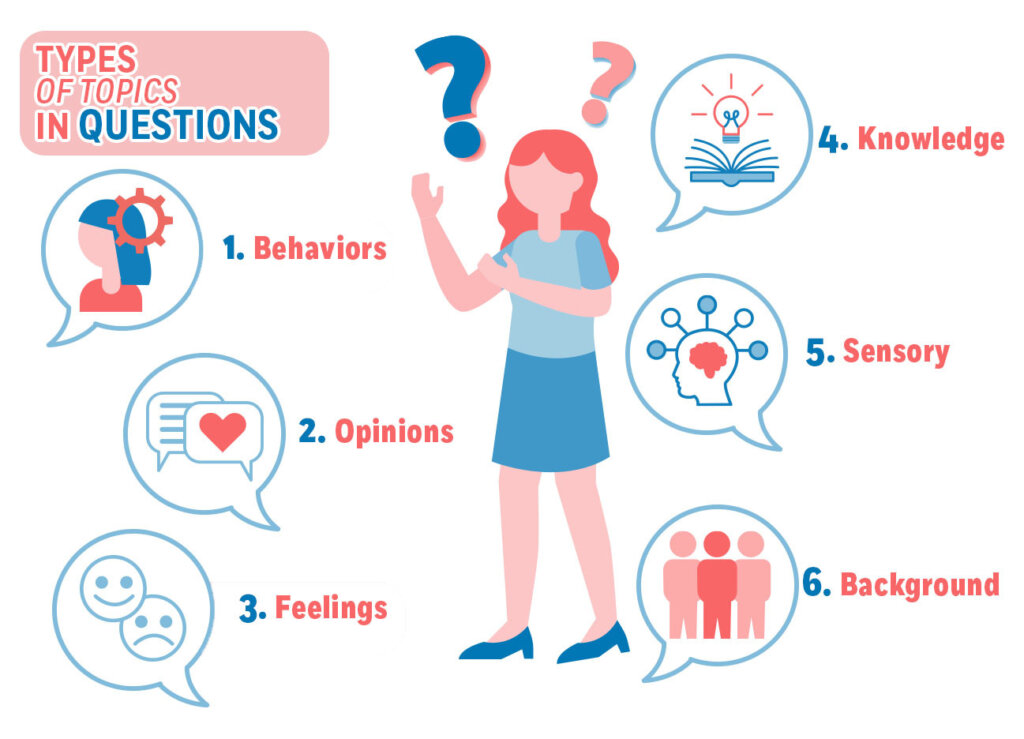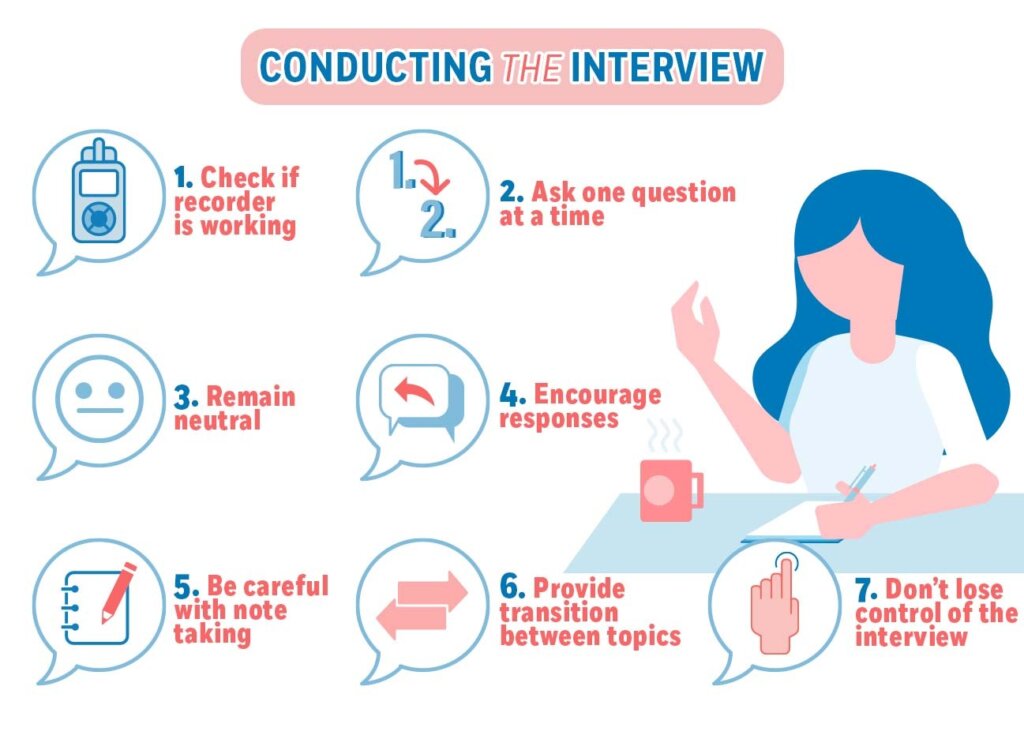General Guidelines for Conducting Interviews
© Copyright Carter McNamara, MBA, PhD, Authenticity Consulting, LLC.
Adapted from the Field Guide to Consulting and Organizational Development.
Sections of This Topic Include
- Introduction
- Preparation for Interview
- Types of Interviews
- Types of Topics in Questions
- Sequence of Questions
- Wording of Questions
- Carrying Out Interview
- Immediately After Interview
- Other Resources
*General Information and Resources
*Ethics and Conducting Research
Also consider
Learn More in the Library’s Blogs Related to Doing Research Interviews
In addition to the articles on this current page, see the following blogs which have posts related to Doing Research Interviews. Scan down the blog’s page to see various posts. Also see the section “Recent Blog Posts” in the sidebar of the blog or click on “next” near the bottom of a post in the blog.
- Library’s Business Planning Blog
- Library’s Building a Business Blog
- Library’s Strategic Planning Blog
Introduction
Interviews are particularly useful for getting the story behind a participant’s experiences. The interviewer can pursue in-depth information around a topic. Interviews may be useful as follow-up to certain respondents to questionnaires, e.g., to further investigate their responses. Usually open-ended questions are asked during interviews.
Before you start to design your interview questions and process, clearly articulate to yourself what problem or need is to be addressed using the information to be gathered by the interviews. This helps you keep clear focus on the intent of each question.
Preparation for Interview

- Choose a setting with little distraction.
Avoid loud lights or noises, ensure the interviewee is comfortable (you might ask them if they are), etc. Often, they may feel more comfortable at their own places of work or homes. - Explain the purpose of the interview.
- Address terms of confidentiality. Note any terms of confidentiality. (Be careful here. Rarely can you absolutely
promise anything. Courts may get access to information, in certain circumstances.) Explain who will get access to their answers and how their answers will be analyzed. If their comments are to be used as quotes, get their written permission to do so. See getting informed consent. - Explain the format of the interview.
Explain the type of interview you are conducting and its nature. If you want them to ask questions, specify if they’re to do so as they have them or wait until the end of the interview. - Indicate how long the interview usually takes.
- Tell them how to get in touch with you later if they want to.
- Ask them if they have any questions before you both get started with the interview.
- Don’t count on your memory to recall their answers.
Ask for permission to record the interview or bring along someone to take notes.
Types of Interviews
- Informal, conversational interview – no predetermined questions are asked, in order to remain as open and adaptable as possible to the interviewee’s nature and priorities; during the interview, the interviewer “goes with
the flow”. - General interview guide approach – the guide approach is intended to ensure that the same general areas of information are collected from each interviewee; this provides more focus than the conversational approach, but
still allows a degree of freedom and adaptability in getting information from the interviewee. - Standardized, open-ended interview – here, the same open-ended questions are asked to all interviewees (an open-ended question is where respondents are free to choose how to answer the question, i.e., they don’t select “yes” or “no” or provide a numeric rating, etc.); this approach facilitates faster interviews that can be more easily analyzed and compared.
- Closed, fixed-response interview – where all interviewees are asked the same questions and asked to choose answers from among the same set of alternatives. This format is useful for those not practiced in interviewing.
Types of Topics in Questions

Patton notes six kinds of questions. One can ask questions about:
- Behaviors – about what a person has done or is doing
- Opinions/values – about what a person thinks about a topic
- Feelings – note that respondents sometimes respond with “I think …” so be careful to note that you’re looking for feelings
- Knowledge – to get facts about a topic
- Sensory – about what people have seen, touched, heard, tasted or smelled
- Background/demographics – standard background questions, such as age, education, etc.
Note that the above questions can be asked in terms of past, present or future.
Sequence of Questions
- Get the respondents involved in the interview as soon as possible.
- Before asking about controversial matters (such as feelings and conclusions), first ask about some facts. With this approach, respondents can more easily engage in the interview before warming up to more personal matters.
- Intersperse fact-based questions throughout the interview to avoid long lists of fact-based questions, which tends to leave respondents disengaged.
- Ask questions about the present before questions about the past or future. It’s usually easier for them to talk
about the present and then work into the past or future. - The last questions might be to allow respondents to provide any other information they prefer to add and their impressions of the interview.
Wording of Questions
- Wording should be open-ended. Respondents should be able to choose their own terms when answering questions.
- Questions should be as neutral as possible. Avoid wording that might influence answers, e.g., evocative, judgmental wording.
- Questions should be asked one at a time.
- Questions should be worded clearly. This includes knowing any terms particular to the program or the respondents’ culture.
- Be careful asking “why” questions. This type of question infers a cause-effect relationship that may not truly exist. These questions may also cause respondents to feel defensive, e.g., that they have to justify their response, which may inhibit their responses to this and future questions.
Conducting Interview

- Occasionally verify the tape recorder (if used) is working.
- Ask one question at a time.
- Attempt to remain as neutral as possible. That is, don’t show strong emotional reactions to their responses. Patton suggests to act as if “you’ve heard it all before.”
- Encourage responses with occasional nods of the head, “uh huh”, etc.
- Be careful about the appearance when note taking. That is, if you jump to take a note, it may appear as if you’re surprised or very pleased about an answer, which may influence answers to future questions.
- Provide transition between major topics, e.g., “we’ve been talking about (some topic) and now I’d like to move on to (another topic).”
- Don’t lose control of the interview. This can occur when respondents stray to another topic, take so long to answer a question that times begins to run out, or even begin asking questions to the interviewer.
Immediately After Interview
- Verify if the tape recorder, if used, worked throughout the interview.
- Make any notes on your written notes, e.g., to clarify any scratchings, ensure pages are numbered, fill out any notes that don’t make senses, etc.
- Write down any observations made during the interview. For example, where did the interview occur and when, was the respondent particularly nervous at any time? Were there any surprises during the interview? Did the tape recorder break?
Other Resources
For the Category of Evaluations (Many Kinds):
To round out your knowledge of this Library topic, you may want to review some related topics, available from the link below. Each of the related topics includes free, online resources.
Also, scan the Recommended Books listed below. They have been selected for their relevance and highly practical nature.

